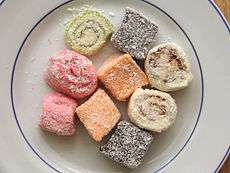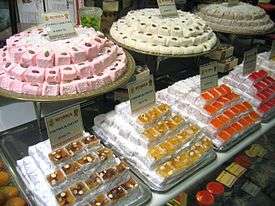Turkish delight
|
An assortment of Turkish delight | |
| Alternative names | Lokum |
|---|---|
| Course | Sweet |
| Place of origin | Ottoman Empire[1] |
| Creator | Hacı Bekir Efendi[2][3] |
| Serving temperature | Room temperature |
| Main ingredients | Starch, sugar |
| Variations | Multiple |
|
| |
Turkish delight, lokum or rahat lokum and many other transliterations[4] (Ottoman Turkish: رَاحَة الْحُلْقُوم rāḥat al-ḥulqūm, Turkish: Lokum or rahat lokum, from colloquial Arabic: راحه الحلقوم rāḥat al-ḥalqūm)[1] is a family of confections based on a gel of starch and sugar. Premium varieties consist largely of chopped dates, pistachios, and hazelnuts or walnuts bound by the gel; traditional varieties are mostly gel, generally flavored with rosewater, mastic, Bergamot orange, or lemon. The confection is often packaged and eaten in small cubes dusted with icing sugar, copra, or powdered cream of tartar, to prevent clinging. Other common flavors include cinnamon and mint. In the production process, soapwort may be used as an emulsifying additive.
History


The exact origin of these sweets is yet to be definitively determined; however, "lokum" comes from the Arabic Halkum or Al-Halkum. In the Arab world, Turkish delights are called rāḥat al-ḥulqūm (رَاحَة الْحُلْقُوم) which means "Throat Comfort".
According to the Hacı Bekir company, the sweets as they are known today were developed by Bekir Efendi, named Hacı Bekir, after performing the Hajj. He moved to Istanbul from his hometown Kastamonu and opened his confectionery shop in the district of Bahçekapı in 1777.[5] The company still operates under the founder's name.[2][3]
Tim Richardson, a historian of sweets, has questioned the claim of Hacı Bekir to be the creator of Turkish Delight, writing that "specific names and dates are often erroneously associated with the invention of particular sweets, not least for commercial reasons".[6][7]
Ottoman confectionery was originally sweetened with honey and molasses, using water and flour as the binding agents, with rosewater, lemon peel and bitter orange as the most common flavors (red, yellow and green). Hacı Bekir introduced the use of glucose in 1811, shortly after it had been discovered by Gottlieb Kirchhoff.
Lokum was introduced to Western Europe in the 19th century. An unknown Briton reputedly became very fond of the delicacy during his travels to Istanbul and purchased cases of it, to be shipped back to Britain under the name Turkish Delight. It became a major delicacy in Britain and throughout Continental Europe for high class society. During this time, it became a practice among upper class socialites to exchange pieces of Turkish Delight wrapped in silk handkerchiefs as presents. [8]
Name
The Turkish names lokma and lokum are derived from the Arabic word luqma(t) and its plural luqūm meaning "morsel" and "mouthful"[9] and the alternative Ottoman Turkish name, rahat-ul hulküm,[10] was an Arabic formulation, rāḥat al-hulqūm, meaning "comfort of the throat", which remains the name in formal Arabic.[11] In Libya, Saudi Arabia, and Tunisia it is known as ḥalqūm, while in Kuwait it is called كبده الفرس "chabdat alfaras" and in Egypt it is called malban (ملبن [ˈmælbæn]) or ʕagameyya and in Syria rāḥa. Its name in various Eastern European languages comes from Ottoman Turkish lokum or rahat-ul hulküm. Its name in Greek, λουκούμι (loukoumi) shares a similar etymology with the modern Turkish and it is marketed as Greek Delight. In Cyprus, where the dessert has protected geographical indication (PGI),[12][13] it is also marketed as Cyprus Delight. In Armenian it is called lokhum (լոխում). Its name in Bosnian is rahat lokum, and derives from a very old confusion of the two Ottoman Turkish names found already in Ottoman Turkish;[10] indeed this mixed name can also be found in Turkey today. Its name in Serbo-Croatian is ratluk, a reduced form of the same name. In Persian, it is called rāhat-ol-holqum (Persian: راحت الحلقوم).[14]
In English, it was formerly alternatively known as Lumps of Delight.[15]
Around the world
Europe
Bulgaria
In Bulgarian, Turkish Delight, known as lokum (локум) is also very popular and has been in the local culture for a while, presumably it came with the Ottoman Empire, but perhaps earlier, as the Orient has been very influential to the country in terms of cuisine. Bulgaria produces its own brands of lokum, plain or spiced with rose petals, white walnuts or "endreshe".
Greece
In Greece, Turkish Delight, known as loukoumi [λουκούμι] has been a very popular delicacy since the 19th century, famously produced in the city of Patras, Patrina loukoumia, as well as on the island of Syros and the northern Greek cities Serres and Komotini but elsewhere as well. Loukoumi is a common traditional treat, routinely served instead of biscuits along with Turkish coffee. In addition to the common rosewater and bergamot varieties, Mastic-flavored loukoumi is available and very popular. Another sweet, similar to loukoumi, that is made exclusively in the town of Serres, is Akanés.
Macedonia
In Macedonia, Turkish Delight, known as lokum (локум) is popular, as well as in all former Yugoslav countries. One of the biggest chocolate factories "Evropa" is producing Turkish Delight, and people consume it very frequently.
Romania
The Romanian word to describe this confection is rahat, an abbreviation of the Arabic rahat ul-holkum.[16] However, in the Romanian language, the word rahat took a pejorative sense, in this case a euphemism that translates as shit.[17][18] According to linguist Lazăr Șăineanu, Turkish words which entered the Romanian language in the seventeenth century and eighteenth century became mostly obsolete and acquired a pejorative or ironic sense. Politically and socially, this weakened the influence of Ottoman society, and parts of the Ottoman Turkish language which had not had time to take root in the Romanian language took a touch of irony and became a mine for humorous literature.[19] Rahat is eaten as is or is added in many Romanian cakes called cornulețe, cozonac or salam de biscuiţi.[20] Traditionally in Romania and the Balkans, the rahat is generally served with coffee.
North America
The Nory Candy company in the Greater Los Angeles area has been producing Turkish Delights or Rahat Locum since 1964. The company produces different fruit and exotic flavors including rose and licorice as well a variety which include nuts such as Almonds, Pistachios, and Walnuts. In 1930 two Armenian immigrants, Armen Tertsagian and Mark Balaban, founded Liberty Orchards[21] of Cashmere, Washington, and began manufacturing "Aplets" (apple and walnut locoum) and "Cotlets" (apricot and walnut locoum). In 1984 they added the medley-flavored "Fruit Delights" line in strawberry, raspberry, orange, blueberry, peach, cranberry, and pineapple assortments. Although all of these confections are marketed under American-style brand names, they are referred to on product packaging as "Rahat Locoum".
Turkish Delight also forms the basic foundation of the Big Turk chocolate bar (distributed by Nestle in Canada).
Brazil
The confection is known in Brazil as Manjar Turco, Delícia Turca, Bala de Goma Síria or Bala de Goma Árabe. As with most Middle Eastern dishes, it came with the Levantine Arab diaspora to Latin America.
Britain and the Commonwealth
Fry's Turkish Delight is marketed by Cadbury in the United Kingdom, Australia, and South Africa and can also be found in Canada and New Zealand, which is rosewater-flavoured, and covered on all sides in milk chocolate. UK production controversially moved to Poland in 2010.[22]
The Big Turk chocolate bar made by Nestlé Canada and sold in that country consists of dark magenta Turkish delight coated in milk chocolate.
Protected geographical indication
Despite its worldwide popularity and production in several countries, at present, the only protected geographical indication (PGI) for such a product is the name Λουκούμι Γεροσκήπου (Loukoumi Geroskipou) for Turkish delight made in Yeroskipou, Cyprus.[23]
Related products
Turkish delight was an early precursor to the jelly bean that inspired its gummy interior.[24][25]
There are gourmand perfumes that are based upon Turkish Delight, such as "Loukhoum"[26] by Ava Luxe, "Loukhoum"[27] by Keiko Mecheri, and "Rahät Loukoum"[28] by Serge Lutens.
In popular culture
- Turkish delight features as the addictive confection to which Edmund Pevensie succumbs in The Lion, the Witch and the Wardrobe (1950) by C. S. Lewis. Sales of Turkish delight rose following the theatrical release of the 2005 film version of The Chronicles of Narnia: The Lion, the Witch and the Wardrobe.[29]
- Norwegian artist Susanne Sundfør released a song called "Turkish Delight" with several references to the Chronicles of Narnia.
- Turks fruit, a 1969 Dutch novel written by Jan Wolkers.
- Turkish Delight, a 1973 Dutch film about the love story of an artist and a young woman.
- "Rahadlakum" is the title of a major production number in Act 2 of the Wright and Forrest musical Kismet. The Wazir's wife, Lalume, seduces Hajj the poet with the confection, setting up the finale.
- In The Paradise, Miss Audrey, the head of ladieswear department, falls ill and loses her voice. Her former beau, the department store's direct competitor, brings her "Lumps of Delight". He knows that her illness is psychological, as the only other time she lost her voice was after his proposal.
- Turkish delight is an element in the 1930 Lord Peter Wimsey novel Strong Poison, by Dorothy L. Sayers.
See also
- Big Turk
- Botan Rice Candy, Gyūhi
- Gumdrop
- Hadji Bey
- Turkish cuisine
- Food portal
References
- 1 2 Sweet Treats around the World: An Encyclopedia of Food and Culture. Books.google.com. pp. 343–346. Retrieved 2015-12-21.
- 1 2 "History of Hacı Bekir". www.hacibekir.com. Retrieved 7 February 2016.
- 1 2 Combe, Victoria (3 May 2003). "Sweet little history". The Telegraph. Retrieved 7 February 2016.
- ↑ Rahat Lokum, entry from British & World English dictionary
- ↑ xvi. Books.google.com. Retrieved 2014-08-01.
- ↑ Richardson, Tim (2003). Sweets, a History of Temptation, p. 51. Bantam Press, London. ISBN 055381446X.
- ↑ Brown, Jonathan. "The Lion, the Witch & the Turkish Delight", The Independent, London, 5 December 2005. Retrieved on 5 December 2005.
- ↑ Bayram, Seker (14 July 2015). "Turkish Delight AKA Lokum". Marmaris Bay Cruisers. Retrieved 13 January 2016.
- ↑ Diran Kélékian, Dictionnaire Turc-Français (Ottoman Turkish), 1911
- 1 2 James Redhouse, A Turkish and English Dictionary, 1856, p.707.
- ↑ Hans Wehr, A Dictionary of Modern Written Arabic, 1966, p.365
- ↑ "COUNCIL REGULATION (EC) No 510/2006". Official Journal of the European Union. 2007-04-21. Retrieved 2015-11-15.
- ↑ "COMMISSION REGULATION (EC) No 1485/2007". Official Journal of the European Union. 2007-12-14. Retrieved 2015-11-15.
- ↑ Colin Turner, A Thematic Dictionary of Modern Persian, 2004
- ↑ Oxford English Dictionary
- ↑ Lazăr Șăineanu, Influența orientală asupra limbii și culturii românești, 1900
- ↑ "Dictionnaire franco roumain" (PDF). Projet babel (in Romanian).
- ↑ Yann Picand, Dominique Dutoit. "Traduction de merde en roumain | dictionnaire français-roumain". Traduction.sensagent.com. Retrieved 2014-08-01.
- ↑ "INFLUENTA LIMBII TURCE ASUPRA LIMBII ROMǺNE" (in Romanian). scritube.com.
- ↑ Marks, Gil (2010). Encyclopedia of Jewish Food. Wiley. ISBN 9780470943540.
- ↑ https://www.libertyorchards.com/story
- ↑ Bouckley, Ben. (July 30, 2010). "Final UK-made Cadbury Chrunchie bars from September". Retrieved June 12, 2015.
- ↑ "DOOR". Ec.europa.eu. Retrieved 2014-08-01.
- ↑ Moncel, Bethany. "The History of Jelly Beans". About.com. Retrieved 2015-09-14.
- ↑ Olver, Lynne (2015-01-09). "history notes-candy". The Food Timeline. Retrieved 2014-08-01.
- ↑ "Loukhoum by Ava Luxe - Basenotes Fragrance Directory". Basenotes.net. Retrieved 2014-08-01.
- ↑ "Loukhoum by Keiko Mecheri (2002) - Basenotes Fragrance Directory". Basenotes.net. Retrieved 2014-08-01.
- ↑ "Rahät Loukoum by Serge Lutens Les Salons du Palais Royal Shiseido (1998) - Basenotes Fragrance Directory". Basenotes.net. Retrieved 2014-08-01.
- ↑ "Turkish Delight Sales Jump After Narnia Chronicles". Info.nhpr.org. 2006-02-17. Retrieved 2014-08-01.
External links
| Wikibooks Cookbook has a recipe/module on |
-
 Media related to Lokum at Wikimedia Commons
Media related to Lokum at Wikimedia Commons
| ||||||||||||||||||||||||||||||||||||||||||||||||||
| ||||||||||||||||||||||||||||||||||||||||||||||||||

.jpg)